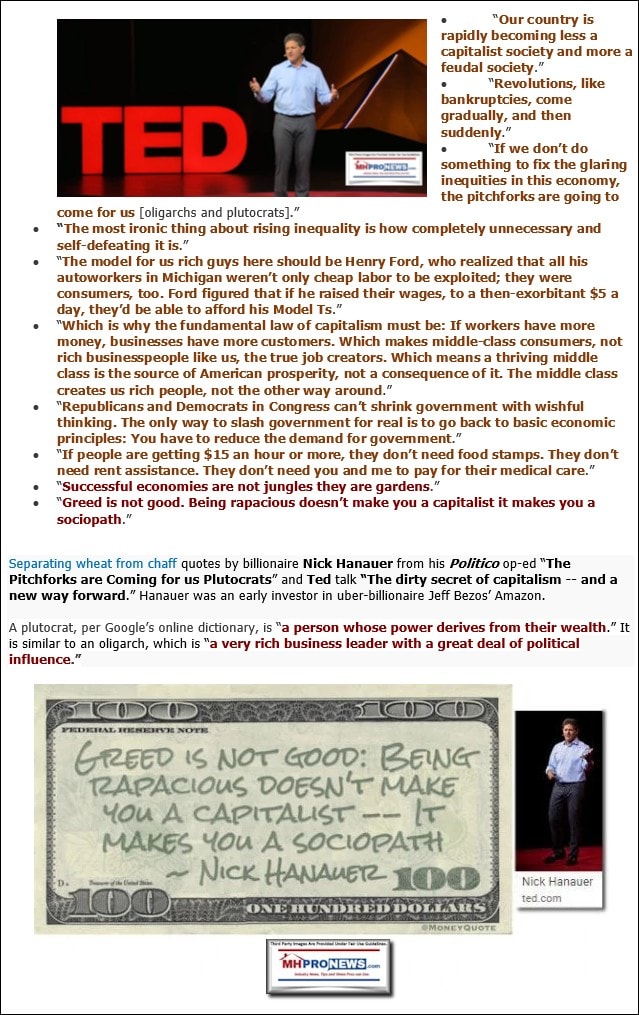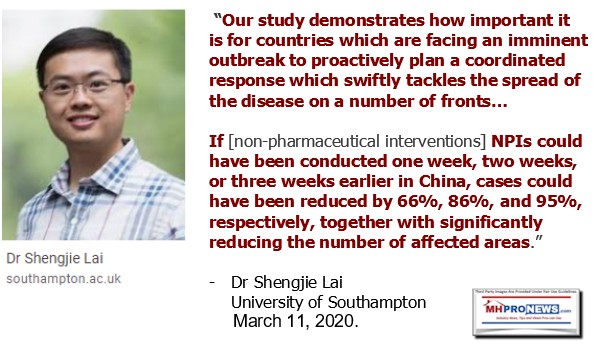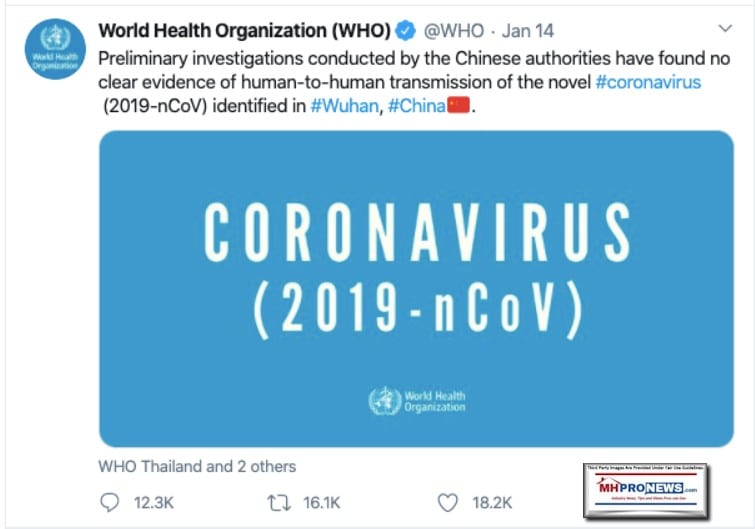It’s been a year unlike any other in the lifetime of living Americans. There are several reasons why the year of surprise disruptions could intensify in the weeks and months ahead.
“It [COVID19] has strengthened hard-liners in both countries, and political pressures stemming from the pandemic are making it harder for leaders to back away from escalation. For two straight months, as the virus killed thousands and wreaked economic havoc around the world, officials of the two superpowers have heaped blame on each other,” the L.A. Times, AP and Bakersfield reported.
Business as usual (BAU) in the relationship between the U.S. and China is apparently at the beginning of an end or serious shift.
How manufactured housing industry professionals respond or pivot to those developing pressures could make the difference between a brighter or darker future.
The COVID19 pandemic revealed just how dangerously and foolishly dependent on Chinese supply chains the United States has become. Trade policies begun nearly 4 decades ago by the Nixon Administration during the Cold War era in hopes of changing the direction of U.S.-Chinese Communist relations have proven to be bitterly mistaken.
Republican and Democratic presidents largely followed that lead, even as more of the American supply chain moved offshore. Doing business in China was paid for by Western know-how and investing that pursued cheap labor and/or materials.
Untold hundreds of billions invested in that communist regime fueled the expansion of the Chinese military, cyber, spy and influence network. In an ironic twist, Forbes in 2014 and a congressional hearing in 2019 suggested that the Affordable Care Act (ACA)/ObamaCare provisions pushed more of the U.S. medical supply chains into China.
Democratic researcher and former Washington Post journalist Joel Kotkin pointed to the folly of decades of such practices, and the harm it has caused in California and other states. Kotkin is among those on both sides of the left–right divide that have called for changes or a “de-coupling” from China.
China vs. U.S., Infographic on Chinese Economic Growth, and Manufactured Housing
The decades-long pattern of increasing American dependence on an adversarial nation continued until the Trump Administration’s balancing act of polite talk toward President Xi Jinping while simultaneously establishing increasingly tougher tariffs and rebuilding the U.S. military.
Not only have medical and pharmaceutical supply chains in China proven to be problematic, but it is also evident that manufactured housing supplies originating in China are vulnerable too. Kevin Clayton’s video interview with CNBC linked below that bemoaned tariffs now looks short-sighted for a wing of a Warren Buffett led conglomerate that claims to think in turns of decades or centuries.
As tensions rise between the governments on how China failed to warn the U.S. and the rest of the world early and clearly enough, the potential for disruption in trade post-pandemic only grows.
Beijing’s propaganda campaign to blame shift their responsibilities to the U.S. – indicated by Fox News, Breitbart, the Los Angeles Times, AP, Bakersfield and other sources – has grown. What some see as China’s gifts to Italy or other nations could just as easily be understood as a charm offensive designed to mollify the victims potential rage against the source of their COVID19 problems. Secretary of State Mike Pompeo signaled during the 4.8.2020 White House press conference that the time for sorting out responsibility will be later. Meanwhile, using “Operation Airbridge” to rush supplies into the U.S., American manufacturers are rushing to fill the gap in medical necessities ranging from ventilators, personal protective equipment (PPE) and more.
Tough Choices Ahead for Manufactured Housing…?
As the stage is set for rising tensions between the world’s two largest economies and military rivals, now is the time to swallow hard and prepare a pivot in manufactured housing supply chains too.
Yes, making a switch means costs will rise. But if a longer-term view is taken, ultimately on-shoring supply chains means that demand for American labor could once more increase, thus worker wages will rise to meet that cost differential. It is the principle that Henry Ford advocated which has been echoed by billionaire Nick Hanuer.

As the Russians, Saudi and OPEC leaders begin to move, oil is starting to rebound from disastrously unsustainably low levels to protect U.S. production. That’s a hopeful sign that protects a sector important to HUD Code manufactured housing and modular building on several levels.
Most if not all domestic production of factory-built homes involve Chinese supply chains, several industry sources tell MHProNews.
The Trump Administration signaled last year that they could order American supply chains out of China. That point should not be forgotten.
Because it is unthinkable that the U.S., post-pandemic, will sit idly by without demanding that China take responsibility for the harm caused to our economy. Several Republican leaders have already signaled that steps must follow the taking of the curve of what President Trump has at times called the “Chinese Virus” or “China Virus.”

As certain voices ironically debate the merits or lack thereof on the domestic side of the thinly veiled diplomatic dialogue with Beijing, the name of the virus masks or reveals the core issue. Where did the pandemic originate? Why allowed the true nature of COVID19 to be obscured and covered up, as the example of the purportedly pro-Chinese World Health Organization (WHO) exemplifies?
News reports have emerged that confirmed a point raised weeks ago by MHProNews about U.S. intelligence. At yesterday’s White House press conference it was confirmed that intelligence briefings on what spy agencies were learning about what the anti-communist Epoch Times labels the CCP Virus didn’t reach the president until January.
Recent reports indicate that there were signs in November of 2019 that there were problems inside China related to their original outbreak. Taiwan – the free Republic of China – warned the WHO early on, who apparently ignored the island-nation’s cautionary claim that the virus was capable of human-to-human transmission. British researchers effectively say that earlier warnings could have cut spread by as much as 95 percent. That’s tens of thousands of lives that would have been saved and trillions of dollars in economic activity that would have been protected.

So, not only did China but also the WHO misinformed the world about the risks of easy human-to-human transmission. Those intelligence sources failed to inform President Trump until January, that was during the timeframe that Democrats were engaged in a partisan impeachment.
By January, the “seeding” of the virus here and in nations around the world had already occurred. Yes, stopping travel from China in later January helped slow the growth rate of infections. But the contagious disease had already been silently spreading. No leader of any political or business organization can act without adequately accurate and actionable information.
Curt Hodgson, Legacy Housing’s chairman, in the transcript found in the report linked below made it clear that costs were coming down for several supplies.
Which brings industry professionals to the point of what’s next for American producers of factory-built housing?
It does matter if the origins of the coronavirus were in a bio-weapons lab in Wuhan or through some wet market, which has known risks for such pandemics. But either way, the evidence is clear that the China initially covered up the risks. Thus, Senator John Kennedy (LA-R) who said “China lied, and a lot of people died.”

There are thus responsibilities in China, some with the WHO, but perhaps also with billionaire Bill Gates. The likelihood of a chilling of relations between the U.S. and China is growing. That has implications on manufactured housing. That Republican and Democratic Congressional leaders apparently cashed in on this crisis – including House Speaker’s Nancy Pelosi’s (CA) husband and Republican Senator Kelly Loeffler (GA).
MHProNews recently reported, legal action will also play into the developments between the U.S. and China. Attorneys in Texas, Florida and California are among those who have filed trillions of dollars worth of legal action against the communist Chinese regime. Rephrased, there are numerous reasons to expect problems in the U.S. China trade relationship that could or will upend manufactured housing supply chains from that nation.
There will be reports on that topic of what lies ahead for manufactured and modular housing in upcoming reports on MHProNews. Watch for those reports.

That’s a wrap on this installment of manufactured home “Industry News Tips and Views Pros Can Use” © where “We Provide, You Decide.” © (Affordable housing, manufactured homes, reports, fact-checks, analysis, and commentary. Third-party images or content are provided under fair use guidelines for media.) (See Related Reports, further below. Text/image boxes often are hot-linked to other reports that can be access by clicking on them.)

By L.A. “Tony” Kovach – for MHLivingNews.com.
Tony earned a journalism scholarship and earned numerous awards in history and in manufactured housing. For example, he earned the prestigious Lottinville Award in history from the University of Oklahoma, where he studied history and business management. He’s a managing member and co-founder of LifeStyle Factory Homes, LLC, the parent company to MHProNews, and MHLivingNews.com. This article reflects the LLC’s and/or the writer’s position, and may or may not reflect the views of sponsors or supporters.
Connect on LinkedIn: http://www.linkedin.com/in/latonykovach
Related References:
The text/image boxes below are linked to other reports, which can be accessed by clicking on them.
Are Manufactured Housing Supply Chains in China Threatened by Coronavirus?






























